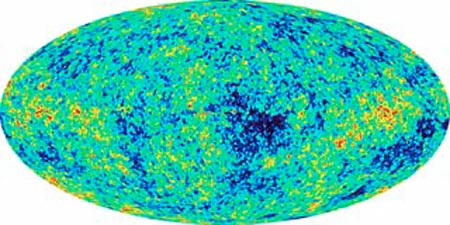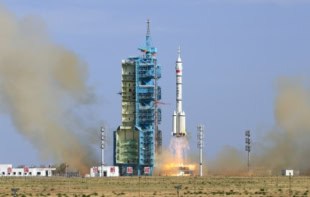
“If you’re religious, it’s like seeing God.” So said George Smoot of Lawrence Berkeley National Laboratory in 1992 when he announced the discovery of tiny ripples in the radiation left over from the Big Bang. Smoot (who shared the 2006 Nobel Prize for Physics for the discovery) was referring to the possibility that fluctuations in the temperature of the cosmic microwave background as measured by the COBE satellite revealed the seeds of galaxies — and thus of stars, planets and ultimately life itself.
Since then, searching for patterns in this relic radiation has become a popular activity because it provides a snapshot of the universe when it was just 380,000 years old. Furthermore, COBE’s successor — the Wilkinson Microwave Anisotropy Probe (WMAP) — has increased the resolution of this snapshot enormously, opening a window onto the universe at even earlier times.
So far a mysterious cold spot some billion light-years across has turned up in the WMAP data, not to mention a series of hot and cold patches dubbed “an axis of evil” because it defies conventional explanation. But physicists in the UK and Switzerland now claim to have seen tentative signs of something slightly more tangible: “cosmic strings” that could be the relics of cosmic phase transitions that took place in the first trillionths of a second after the Big Bang.
Cosmological defects
The cosmic microwave background (CMB) is best understood via inflation, a period of rapid expansion that took place 10–35 seconds after the Big Bang. Inflation is thought to have blown up initial quantum fluctuations in space–time to cosmological scales, leading to the density perturbations and thus the hot and cold patches in the CMB seen today. Crucially, inflation also explains why the universe is so isotropic on the largest scales (the CMB is the same to 1 part in 105 in all directions). But the theory is somewhat ad hoc, and physicists would prefer to embed inflation in a more fundamental framework — such as grand unified theory (GUT), which unifies the electromagnetic, strong and weak forces, or superstring theory, which incorporates gravity as well as the other three forces.
Cosmic strings — massive 1D objects that can be billions of light-years long — arise naturally in such frameworks. They are predicted to form during phase transitions as the early universe expanded and cooled, and are analogous to crystal defects that form in ice when water is cooled below freezing. Such cosmic phase changes are associated with broken symmetries of nature, for example when the electroweak force (which is described by the Standard model of particle physics) separated out into the electromagnetic and weak forces that we experience today. Indeed, the breaking of such a symmetry, which would have formed a more complex cosmic defect called “texture”, has already been proposed to explain the giant cold spot in the WMAP data.
Detecting cosmic strings would therefore provide a direct link to the physics of the first few moments of the universe, bridging the ultimate gap between large and small. “A conclusive discovery would be momentous,” says Craig Hogan of the University of Washington.
String simulations
Neil Bevis and colleagues at the University of Sussex and Martin Kunz at the University of Geneva have now simulated the CMB on a computer using models with and without cosmic strings (Phys. Rev. Lett. 100 021301). Because cosmic strings would be present long after the initial quantum fluctuations, they would contribute an additional independent source of CMB perturbations to those from inflation. Comparing the models to the WMAP data, the team found that a model in which 11% of the contribution came from cosmic strings and the rest from inflation was preferred over one that contains no strings at all.
However, the agreement between the data and the model that contained strings (which were of the sort associated with GUTs rather than with superstring theory) corresponded to just two standard deviations. Roughly speaking, this means that if the researchers had datasets from 100 WMAP missions then they would find such “evidence” in about five of them purely due to random variations. “The authors have certainly not claimed a detection of cosmic strings,” says Tom Kibble of Imperial College in London, who pioneered the concept of cosmic strings in the late 1970s.
Limit on string tension
Pedro Ferreira of Oxford University says that although the statistical significance is small, it is still an interesting result because it provides an upper limit on the string tension. “In the context of GUTs, this tells you when unification might have happened or, more specifically, below which energy,” he says.
I would be delighted if there were a confirmed detection of cosmic strings. But we need a lot more evidence before getting too excited! Tom Kibble,Imperial College
However, Kibble also points out that because cosmic strings are expected to emit gravitational waves, such limits potentially conflict with more sensitive ones derived from pulsars because the very regular orbits of pulsars places an upper limit on the background intensity of gravitational waves. “I would be delighted if there were a confirmed detection of cosmic strings,” he says. “But we need a lot more evidence before getting too excited!”



